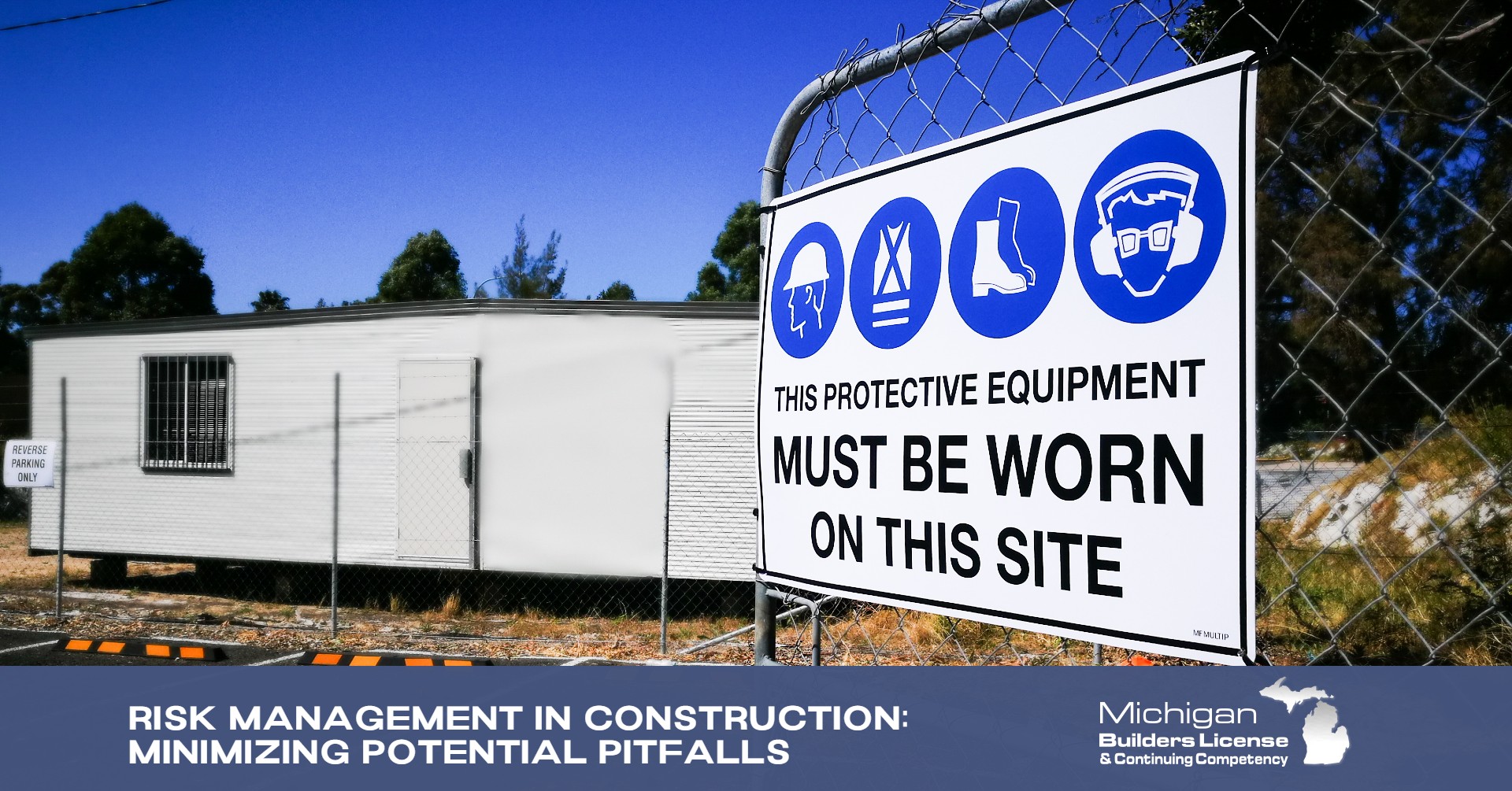Construction projects in Michigan, ranging from small renovations to large-scale developments, come with inherent risks. Understanding and managing these risks is crucial to ensure projects are completed on time, within budget, and without legal or safety issues. Effective risk management can minimize potential pitfalls and lead to more successful project outcomes. Here's how Michigan builders can navigate the complexities of risk management in construction.
Understanding Construction Risks
Construction projects face various types of risks, including:
- Financial Risks: These involve budget overruns, unexpected costs, and cash flow issues.
- Legal Risks: Contract disputes, regulatory compliance, and liability issues fall under this category.
- Safety Risks: Injuries, accidents, and unsafe work environments pose significant threats.
- Environmental Risks: Adverse weather conditions, environmental regulations, and site conditions can impact the project.
- Operational Risks: These include delays in the supply chain, equipment failures, and labor shortages.
Michigan Regulations
Michigan builders must comply with state-specific regulations, including:
- Michigan Occupational Safety and Health Act (MIOSHA): Ensures workplace safety and health standards. (1)
- Michigan Construction Lien Law: Regulates payment and lien rights for contractors and suppliers. (2)
- Michigan Environmental Protection Act: Governs environmental regulations and permitting. (3)
Emerging Risks
- Cybersecurity Threats: Construction companies are increasingly vulnerable to cyber-attacks, which can compromise project data and disrupt operations. (4)
- Supply Chain Disruptions: Global events, such as pandemics and natural disasters, can impact material availability and delivery. (5)
- Climate Change-Related Risks: Extreme weather events and changing environmental conditions can affect project timelines and budgets. (6)
Steps to Effective Risk Management
- Risk Identification
The first step in risk management is identifying potential risks. This involves thorough planning and consultation with all stakeholders. Conducting a risk assessment early in the project helps recognize issues that could arise and allows for proactive measures to mitigate them. Standard tools used for risk identification include SWOT analysis (Strengths, Weaknesses, Opportunities, Threats) and checklists.
- Risk Analysis
Once risks are identified, they need to be analyzed to understand their potential impact and likelihood. This can be done using qualitative and quantitative methods. Qualitative methods involve categorizing risks based on severity and probability, while quantitative methods use numerical data to estimate the impact on project timelines and budgets.
- Risk Prioritization
Not all risks are created equal. Some may have a more significant impact on the project than others. Prioritizing risks based on their potential impact and likelihood of occurrence helps focus on the most critical issues first. This can be achieved through tools like the Risk Matrix, which plots risks on a graph based on their severity and probability.
- Risk Mitigation
Developing strategies to mitigate risks is essential. This can involve:
- Avoidance: Changing project plans to eliminate the risk.
- Transfer: Shifting the risk to another party, such as through insurance or subcontracting.
- Reduction: Implementing measures to reduce the impact or likelihood of the risk.
- Acceptance: Recognizing the risk and deciding to proceed with the project, but with contingency plans in place.
Risk Monitoring and Control
Continuous monitoring of risks throughout the project lifecycle is crucial. This involves regular check-ins, updating risk management plans, and being adaptable to new risks that may emerge. Effective communication among team members and stakeholders ensures that everyone is aware of the current risk status and can respond promptly.
Case Studies
The Big Dig Project: This Boston construction project faced significant cost overruns and delays due to unforeseen site conditions and design changes. Effective risk management strategies, such as early risk identification and mitigation measures, could have minimized these issues. (7)
The Denver International Airport Project: This project encountered numerous risks, including delays, cost overruns, and safety issues. A comprehensive risk management plan, including regular monitoring and updating, helped mitigate these risks and ensure project completion. (8)
Practical Tips for Michigan Builders
Invest in Training
Training employees in risk management practices and safety protocols is essential. Well-trained staff can identify and respond to risks more effectively, reducing the likelihood of accidents and costly mistakes.
Leverage Technology
Modern technology offers various tools for risk management. Project management software can track progress, identify potential delays, and provide real-time updates. Building Information Modeling (BIM) helps visualize project stages and identify potential issues before they arise.
Secure Adequate Insurance
Insurance is a critical component of risk management. Ensure you have adequate coverage for various aspects of the project, including general liability, workers’ compensation, and builder’s risk insurance. This can protect against unforeseen events and financial losses.
Develop Strong Contracts
Clear and comprehensive contracts can help mitigate legal risks. Define roles, responsibilities, timelines, and payment terms clearly. Include clauses that address potential risks and outline procedures for resolving disputes.
Engage with Experienced Professionals
Collaborating with experienced professionals, such as architects, engineers, and legal advisors, can provide valuable insights and help navigate complex regulations and technical challenges.
Effective risk management is vital for the success of construction projects. By identifying, analyzing, prioritizing, and mitigating risks, Michigan builders can minimize potential pitfalls and ensure smoother project execution. Investing in training, leveraging technology, securing insurance, developing strong contracts, and engaging with experienced professionals are practical steps to enhance risk management strategies. By doing so, builders can protect their investments, safeguard their teams, and deliver high-quality projects that meet client expectations.
References
(1) Michigan Occupational Safety and Health Act (MIOSHA). (2022). Michigan Department of Labor and Economic Opportunity.
(2) Michigan Construction Lien Law. (2022). Michigan Legislature.
(3) Michigan Environmental Protection Act. (2022). Michigan Department of Environment, Great Lakes, and Energy.
(4) "Cybersecurity in Construction: A Growing Concern." (2020). Construction Business Owner.
(5) "Supply Chain Disruptions in Construction: Causes and Consequences." (2020). Journal of Construction Engineering and Management.
(6) "Climate Change and Construction: Understanding the Risks and Opportunities." (2020). Building Research & Information.
(7) "The Big Dig Project: A Case Study in Risk Management." (2019). Journal of Construction Engineering and Management.
(8) "The Denver International Airport Project: A Risk Management Success Story." (2018). Construction Management and Economics.





